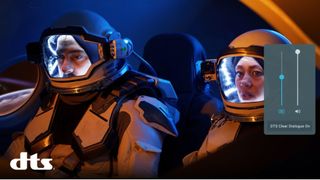There seems to be a fairly consistent criticism of films and TV shows these days concerning sound mixing. I have heard countless complaints of crucial dialogue being drowned out by ambient sound effects or overbearing soundtracks. Take Christopher Nolan's time-bending epic Tenet, in which dialogue is often playing second fiddle to the thumping abstract score or extremely loud gunshots, making the dialogue difficult to follow at times.
Thankfully, DTS has swooped to the rescue with its recently announced AI-powered Clear Dialogue technology, which (if the name doesn't give it away) improves the clarity of dialogue on TV speakers. It's being demonstrated here in Berlin at IFA, I have just heard it in action – and I'm pleasantly surprised at how effective it is.
Now I'm often sceptical about features such as this, as I am most concerned with preserving the director's original intention – why I'm a fan of Filmmaker mode and value picture and sound authenticity over flashy features. In all honesty, this feature does compromise the intent of the creatives and it won't be for everyone, but DTS has an answer to that.
By using the volume buttons on the controller, you can adjust the audio balance to let more of the background noise in if you so desire, which helps to mitigate the sense of isolation of purely focusing on the vocals. I did find the Clear Dialogue feature to be somewhat overbearing in its highest mode, but scaling it back helped to reintroduce some of the desired environmental effects.
This is where DTS's system differs from Samsung's Active Voice Amplifier feature, say, which is more of an on/off solution. It's not only Samsung: Sony and LG also include a dialogue-boosting feature on their TVs that works in a similar way.
DTS has also carefully navigated the "director's intent" argument, stating that there is a disconnect between how content is made and how people consume it. There are undoubtedly more people out there watching the latest Netflix blockbusters on ageing LCD sets with low-quality built-in sound systems than those with the latest high-end OLEDs and surround sound systems.
Ultimately, many people rightfully care about understanding and enjoying the content first and foremost, so sacrificing some of the authenticity for enhanced clarity will be a no-brainer. DTS also highlighted how this feature will be beneficial for older and hard-of-hearing people, and accessibility is always a welcome feature in my books.
The bottom line is that this feature is not made for me. I will stick with the original creative's intent nine times out of ten, and I personally don't see myself using DTS nor anyone else's dialogue-enhancing systems for the time being. However, I can certainly tell that people will absolutely find this system useful, so I won't preach about retaining the director's intent if you value dialogue clarity.
It helps that DTS seems to have done a really solid job of isolating vocals with machine learning and ensuring they sound crisp and detailed (or at least this was the case in my short demo session). The feature is set to come in future TV models (possibly even next year's models) with DTS expecting to offer it to various manufacturers.
MORE:
IFA 2024 news and highlights: the latest turntables, speaker systems, headphones, projectors and more
Check out our picks for the best surround sound systems
DTS:X: what is it? How can you get it?
Dolby Digital vs DTS: what you need to know about the two big surround sound technologies
